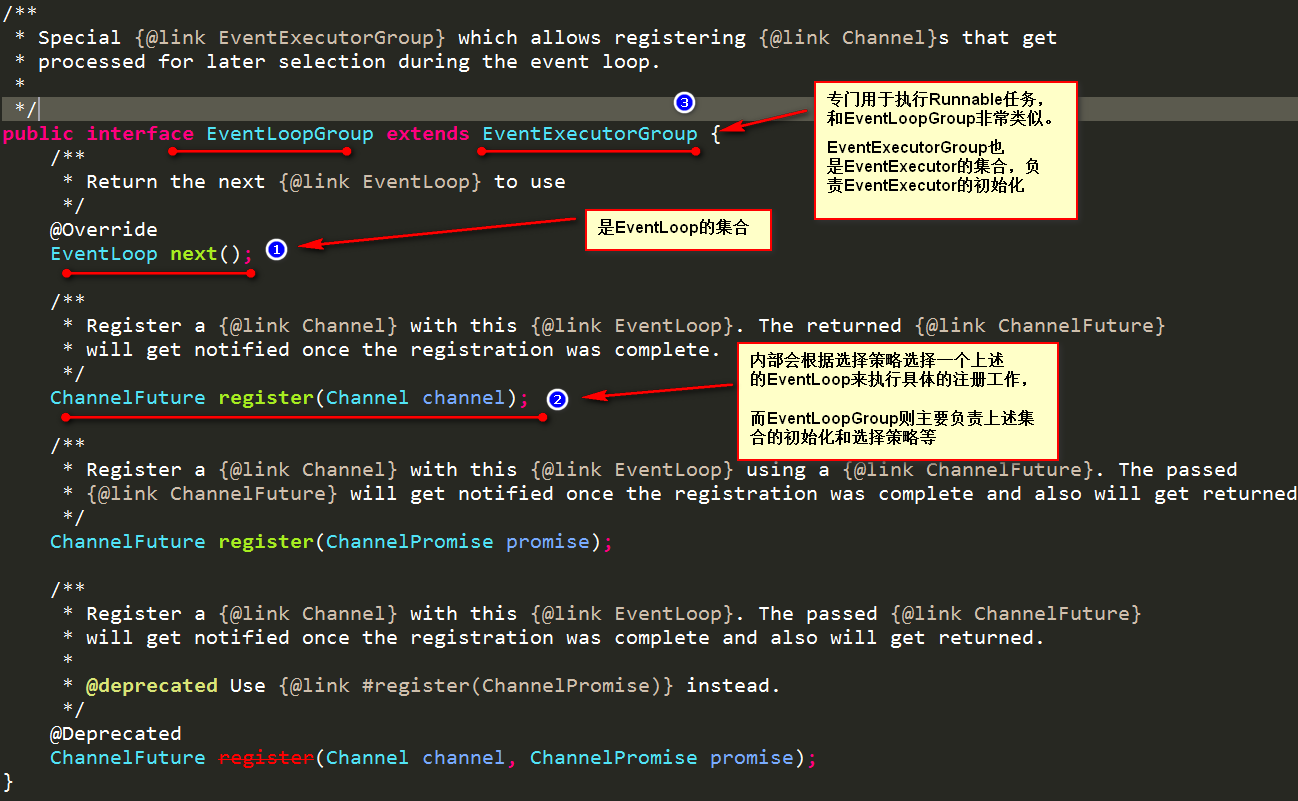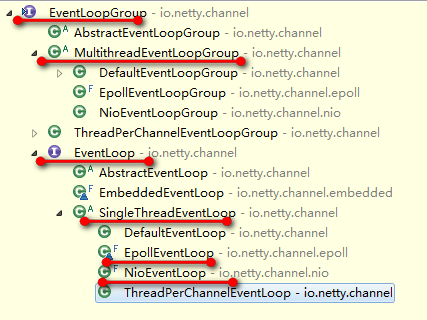分布式Netty源码分析EventLoopGroup及介绍
目录
- EventLoopGroup介绍
- 功能1:先来看看注册Channel
- 功能2:执行一些Runnable任务
- EventLoop介绍
- NioEventLoop介绍
- EpollEventLoop介绍
- 后续
EventLoopGroup介绍
在前面一篇文章中提到了,EventLoopGroup主要负责2个事情,这里再重复下:
它主要包含2个方面的功能,注册Channel和执行一些Runnable任务。

功能1:先来看看注册Channel
即将Channel注册到Selector上,由Selector来调度Channel的相关事件,如读、写、Accept等事件。
而EventLoopGroup的设计是,它包含多个EventLoop(每一个EventLoop通常内部包含一个线程),在执行上述注册过程中是需要选择其中的一个EventLoop来执行上述注册行为,这里就出现了一个选择策略的问题,该选择策略接口是EventExecutorChooser,你也可以自定义一个实现。
从上面可以看到,EventLoopGroup做的工作大部分是一些总体性的工作如初始化上述多个EventLoop、EventExecutorChooser等,具体的注册Channel还是交给它内部的EventLoop来实现。
功能2:执行一些Runnable任务
EventLoopGroup继承了EventExecutorGroup,EventExecutorGroup也是EventExecutor的集合,EventExecutorGroup也是掌管着EventExecutor的初始化工作,EventExecutorGroup对于Runnable任务的执行也是选择内部中的一个EventExecutor来做具体的执行工作。
netty中很多任务都是异步执行的,一旦当前线程要对某个EventLoop执行相关操作,如注册Channel到某个EventLoop,如果当前线程和所要操作的EventLoop内部的线程不是同一个,则当前线程就仅仅向EventLoop提交一个注册任务,对外返回一个ChannelFuture。
总结:EventLoopGroup含有上述2种功能,它更多的是一个集合,但是具体的功能实现还是选择内部的一个item元素来执行相关任务。 这里的内部item元素通常即实现了EventLoop,又实现了EventExecutor,如NioEventLoop等
继续来看看EventLoopGroup的整体类图

从图中可以看到有2路分支:
- 1 MultithreadEventLoopGroup:用于封装多线程的初始化逻辑,指定线程数等,即初始化对应数量的EventLoop,每个EventLoop分配到一个线程

上图中的newChild方法,NioEventLoopGroup就采用NioEventLoop作为实现,EpollEventLoopGroup就采用EpollEventLoop作为实现
如NioEventLoopGroup的实现:
protected EventLoop newChild(Executor executor, Object... args) throws Exception {
return new NioEventLoop(this, executor, (SelectorProvider) args[0],
((SelectStrategyFactory) args[1]).newSelectStrategy(), (RejectedExecutionHandler) args[2]);
}
- 2 EventLoop接口实现了EventLoopGroup接口,主要因为EventLoopGroup中的功能接口还是要靠内部的EventLoop来完成具体的操作
EventLoop介绍
EventLoop主要工作就是注册Channel,并负责监控管理Channel的读写等事件,这就涉及到不同的监控方式,linux下有3种方式来进行事件监听
select、poll、epoll
目前java的Selector接口的实现如下:
PollSelectorImpl:实现了poll方式
EPollSelectorImpl:实现了epoll方式
而Netty呢则使用如下:
NioEventLoop:采用的是jdk Selector接口(使用PollSelectorImpl的poll方式)来实现对Channel的事件检测
EpollEventLoop:没有采用jdk Selector的接口实现EPollSelectorImpl,而是Netty自己实现的epoll方式来实现对Channel的事件检测,所以在EpollEventLoop中就不存在jdk的Selector。
NioEventLoop介绍
对于NioEventLoopGroup的功能,NioEventLoop都要做实际的实现,NioEventLoop既要实现注册功能,又要实现运行Runnable任务
对于注册Channel:NioEventLoop将Channel注册到NioEventLoop内部的PollSelectorImpl上,来监听该Channel的读写事件
对于运行Runnable任务:NioEventLoop的父类的父类SingleThreadEventExecutor实现了运行Runnable任务,在SingleThreadEventExecutor中,有一个任务队列还有一个分配的线程
private final Queue<Runnable> taskQueue; private volatile Thread thread;
NioEventLoop在该线程中不仅要执行Selector带来的IO事件,还要不断的从上述taskQueue中取出任务来执行这些非IO事件。下面我们来详细看下这个过程
protected void run() {
for (;;) {
try {
switch (selectStrategy.calculateStrategy(selectNowSupplier, hasTasks())) {
case SelectStrategy.CONTINUE:
continue;
case SelectStrategy.SELECT:
select(wakenUp.getAndSet(false));
if (wakenUp.get()) {
selector.wakeup();
}
default:
// fallthrough
}
cancelledKeys = 0;
needsToSelectAgain = false;
final int ioRatio = this.ioRatio;
if (ioRatio == 100) {
processSelectedKeys();
runAllTasks();
} else {
final long ioStartTime = System.nanoTime();
processSelectedKeys();
final long ioTime = System.nanoTime() - ioStartTime;
runAllTasks(ioTime * (100 - ioRatio) / ioRatio);
}
if (isShuttingDown()) {
closeAll();
if (confirmShutdown()) {
break;
}
}
} catch (Throwable t) {
...
}
}
}
来详细说下这个过程:
- 1 计算当前是否需要执行select过程
如果当前没有Runnable任务,则执行select(这个select过程稍后详细来说)。
如果当前有Runnable任务,则要去执行处理流程,此时顺便执行下selector.selectNow(),万一有事件发生那就赚了,没有白走这次处理流程
- 2 根据IO任务的时间占比设置来执行IO任务和非IO任务,即上面提到的Runnable任务
如果ioRatio=100则每次都是执行全部的IO任务,执行全部的非IO任务 默认ioRatio=50,即一半时间用于处理IO任务,另一半时间用于处理非IO任务。怎么去控制非IO任务所占用时间呢?
这里是每执行64个非IO任务(这里可能是每个非IO任务比较短暂,减少一些判断带来的消耗)就判断下占用时间是否超过了上述时间限制
接下来详细看下上述select过程
Selector selector = this.selector;
try {
int selectCnt = 0;
long currentTimeNanos = System.nanoTime();
long selectDeadLineNanos = currentTimeNanos + delayNanos(currentTimeNanos);
for (;;) {
long timeoutMillis = (selectDeadLineNanos - currentTimeNanos + 500000L) / 1000000L;
if (timeoutMillis <= 0) {
if (selectCnt == 0) {
selector.selectNow();
selectCnt = 1;
}
break;
}
// If a task was submitted when wakenUp value was true, the task didn't get a chance to call
// Selector#wakeup. So we need to check task queue again before executing select operation.
// If we don't, the task might be pended until select operation was timed out.
// It might be pended until idle timeout if IdleStateHandler existed in pipeline.
if (hasTasks() && wakenUp.compareAndSet(false, true)) {
selector.selectNow();
selectCnt = 1;
break;
}
int selectedKeys = selector.select(timeoutMillis);
selectCnt ++;
if (selectedKeys != 0 || oldWakenUp || wakenUp.get() || hasTasks() || hasScheduledTasks()) {
// - Selected something,
// - waken up by user, or
// - the task queue has a pending task.
// - a scheduled task is ready for processing
break;
}
if (Thread.interrupted()) {
// Thread was interrupted so reset selected keys and break so we not run into a busy loop.
// As this is most likely a bug in the handler of the user or it's client library we will
// also log it.
//
// See https://github.com/netty/netty/issues/2426
if (logger.isDebugEnabled()) {
logger.debug("Selector.select() returned prematurely because " +
"Thread.currentThread().interrupt() was called. Use " +
"NioEventLoop.shutdownGracefully() to shutdown the NioEventLoop.");
}
selectCnt = 1;
break;
}
long time = System.nanoTime();
if (time - TimeUnit.MILLISECONDS.toNanos(timeoutMillis) >= currentTimeNanos) {
// timeoutMillis elapsed without anything selected.
selectCnt = 1;
} else if (SELECTOR_AUTO_REBUILD_THRESHOLD > 0 &&
selectCnt >= SELECTOR_AUTO_REBUILD_THRESHOLD) {
// The selector returned prematurely many times in a row.
// Rebuild the selector to work around the problem.
logger.warn(
"Selector.select() returned prematurely {} times in a row; rebuilding Selector {}.",
selectCnt, selector);
rebuildSelector();
selector = this.selector;
// Select again to populate selectedKeys.
selector.selectNow();
selectCnt = 1;
break;
}
currentTimeNanos = time;
}
} catch (CancelledKeyException e) {
...
}
- 1 首先计算此次select过程的截止时间
protected long delayNanos(long currentTimeNanos) {
ScheduledFutureTask<?> scheduledTask = peekScheduledTask();
if (scheduledTask == null) {
return SCHEDULE_PURGE_INTERVAL;
}
return scheduledTask.delayNanos(currentTimeNanos);
}
这里其实就是从一个定时 任务队列中取出定时任务,如果有则计算出离当前定时任务的下一次执行时间之差,如果没有则按照固定的1s作为select过程的时间
- 2 将当前时间差转化成ms
如果当前时间差不足0.5ms的话,即timeoutMillis<=0,并且是第一次执行,则认为时间太短执行执行一次selectNow
- 3 如果有任务,则立即执行一次selectNow,跳出for循环
- 4 然后就是普通的selector.select(timeoutMillis)
在这段时间内如果有事件则跳出for循环,如果没有事件则已经花费对应的时间差了,再次执行for循环,计算的timeoutMillis就会小于0,也会跳出for循环
在上述逻辑中,基本selectCnt都是1,不会出现很多次,而这里针对selectCnt有很多次的处理是基于一个情况:
selector.select(timeoutMillis)
Selector的正常逻辑是一旦有事件就返回,没有事件则最多等待timeoutMillis时间。 然而底层操作系统实现可能有bug,会出现:即使没有产生事件就直接返回了,并没有按照要求等待timeoutMillis时间。
现在的解决办法就是: 记录上述出现的次数,一旦超过512这个阈值(可设置),就重新建立新的Selector,并将之前的Channel也全部迁移到新的Selector上
至此,NioEventLoop的主逻辑流程就介绍完了,之后就该重点介绍其中对于IO事件的处理了。然后就会引出来ChannelPipeline的处理流程
EpollEventLoop介绍
EpollEventLoop和NioEventLoop的主流程逻辑基本上是差不多的,不同之处就在于EpollEventLoop用epoll方式替换NioEventLoop中的PollSelectorImpl的poll方式。
这里不再详细说明了,之后会详细的说明Netty的epoll方式和jdk中的epoll方式的区别。
后续
下一篇就要详细描述下NioEventLoop对于IO事件的处理,即ChannelPipeline的处理流程。
以上就是分布式Netty源码分析EventLoopGroup及介绍的详细内容,更多关于分布式Netty EventLoopGroup源码分析的资料请关注我们其它相关文章!

